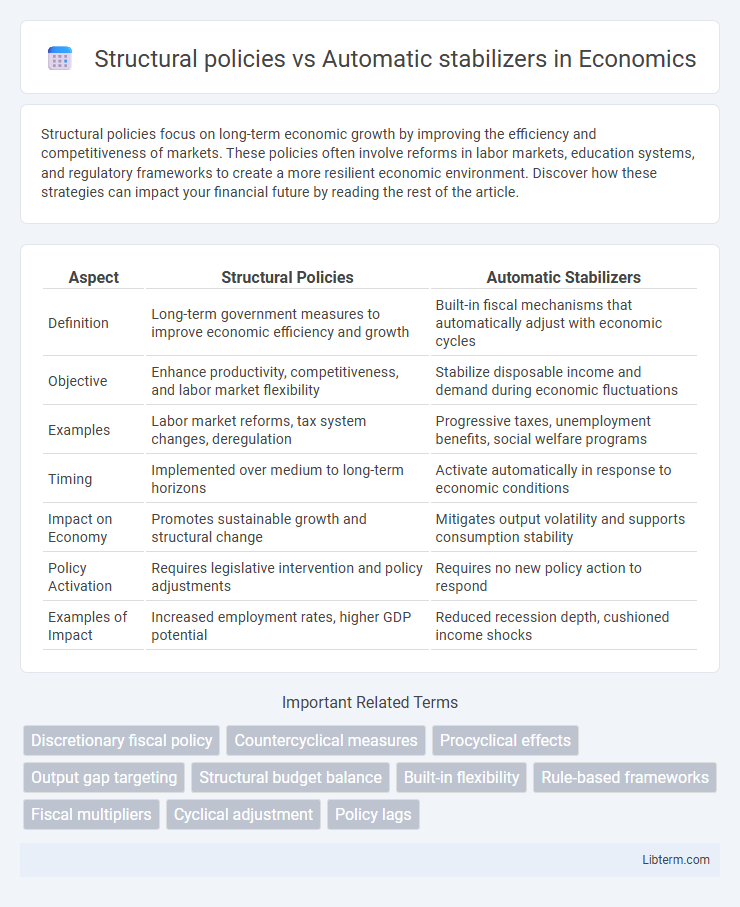Structural policies focus on long-term economic growth by improving the efficiency and competitiveness of markets. These policies often involve reforms in labor markets, education systems, and regulatory frameworks to create a more resilient economic environment. Discover how these strategies can impact your financial future by reading the rest of the article.
Table of Comparison
| Aspect | Structural Policies | Automatic Stabilizers |
|---|---|---|
| Definition | Long-term government measures to improve economic efficiency and growth | Built-in fiscal mechanisms that automatically adjust with economic cycles |
| Objective | Enhance productivity, competitiveness, and labor market flexibility | Stabilize disposable income and demand during economic fluctuations |
| Examples | Labor market reforms, tax system changes, deregulation | Progressive taxes, unemployment benefits, social welfare programs |
| Timing | Implemented over medium to long-term horizons | Activate automatically in response to economic conditions |
| Impact on Economy | Promotes sustainable growth and structural change | Mitigates output volatility and supports consumption stability |
| Policy Activation | Requires legislative intervention and policy adjustments | Requires no new policy action to respond |
| Examples of Impact | Increased employment rates, higher GDP potential | Reduced recession depth, cushioned income shocks |
Understanding Structural Policies
Structural policies refer to long-term economic reforms aimed at improving a country's productivity and growth potential by addressing underlying institutional or market inefficiencies such as labor market rigidities, tax structures, or regulatory frameworks. Unlike automatic stabilizers, which are built-in fiscal mechanisms like unemployment benefits and progressive taxes that respond quickly to economic fluctuations, structural policies require deliberate government action and typically yield effects over an extended period. Understanding structural policies involves recognizing their role in enhancing supply-side capacity and fostering sustainable economic stability rather than providing immediate cyclical relief.
Defining Automatic Stabilizers
Automatic stabilizers are fiscal mechanisms embedded in government budgets that naturally counterbalance economic fluctuations without the need for new legislative actions. Key examples include unemployment insurance and progressive income taxes, which increase government spending or reduce tax burdens when the economy slows, thereby supporting aggregate demand. These stabilizers operate continuously, providing immediate economic relief and dampening cyclical volatility more efficiently than structural policies that require deliberate reforms.
Key Differences Between Structural Policies and Automatic Stabilizers
Structural policies involve long-term government measures such as tax reforms, labor market regulations, and infrastructure investments aimed at enhancing economic growth and stability over time. Automatic stabilizers are built-in fiscal mechanisms like progressive taxation and unemployment benefits that automatically adjust government spending and revenue based on economic fluctuations without additional legislative action. The key difference lies in structural policies requiring deliberate implementation to influence economic structures, while automatic stabilizers operate continuously to moderate economic cycles without direct intervention.
The Role of Structural Policies in Economic Growth
Structural policies play a critical role in economic growth by addressing long-term impediments such as labor market rigidities, inadequate infrastructure, and inefficient regulatory frameworks. These reforms enhance productivity, encourage investment, and foster innovation, thereby creating a more competitive and resilient economy. By improving the foundational institutions and market mechanisms, structural policies support sustained growth beyond short-term economic fluctuations managed by automatic stabilizers.
How Automatic Stabilizers Support Economic Stability
Automatic stabilizers such as unemployment benefits and progressive tax systems reduce fluctuations in disposable income, thereby supporting consumer spending during economic downturns. These mechanisms operate without direct government intervention, enabling timely responses that dampen recessionary impacts and moderate inflationary pressures. Structural policies, while essential for long-term economic growth, typically require legislative changes and delayed implementation, making automatic stabilizers crucial for immediate economic stability.
Policy Implementation: Long-term vs. Short-term Measures
Structural policies involve long-term measures aimed at improving economic fundamentals such as labor market reforms, infrastructure investments, and regulatory changes to enhance productivity and growth. Automatic stabilizers function as short-term mechanisms, including unemployment benefits and progressive taxation, that automatically adjust to economic fluctuations without new legislative action, providing immediate demand support during downturns. The distinct implementation timelines highlight structural policies' role in sustainable growth, while automatic stabilizers offer timely cushioning to stabilize the economy.
Fiscal Impact: Structural Reforms and Automatic Adjustments
Structural policies implement long-term fiscal reforms targeting government spending and revenue frameworks to enhance economic stability and growth, often involving tax code revisions and public sector efficiency improvements. Automatic stabilizers, such as unemployment benefits and progressive taxation, provide immediate fiscal adjustments that counteract economic fluctuations by automatically increasing or decreasing government budgets in response to changes in economic activity. The fiscal impact of structural reforms is gradual and enduring, shaping the baseline budget, while automatic stabilizers deliver rapid, cyclical fiscal responses that smooth short-term economic volatility.
Challenges in Designing Effective Structural Policies
Designing effective structural policies requires addressing challenges such as accurately targeting long-term economic issues like labor market rigidities and innovation deficits without causing market distortions. Policymakers must balance flexibility and predictability to ensure reforms promote sustainable growth while maintaining social acceptance and political feasibility. Additionally, the delayed impact of structural policies complicates the evaluation and adjustment processes compared to automatic stabilizers, which respond quickly to economic fluctuations.
Advantages and Limitations of Automatic Stabilizers
Automatic stabilizers, such as progressive taxes and unemployment benefits, provide rapid economic support by automatically increasing government spending or decreasing tax burdens during downturns without the need for new legislation. Their advantages include timely intervention, reduced policy implementation delays, and built-in countercyclical effects that help smooth business cycles. Limitations involve potentially insufficient stimulus during severe recessions, reduced effectiveness if tax structures are flawed, and inability to address structural economic issues requiring targeted policy measures.
Integrating Structural Policies and Automatic Stabilizers for Resilient Economies
Integrating structural policies with automatic stabilizers enhances economic resilience by addressing both long-term growth and short-term fluctuations. Structural policies promote sustainable productivity improvements, while automatic stabilizers like unemployment benefits and progressive taxation provide immediate countercyclical support during downturns. Coordinated implementation ensures balanced economic stability and growth, reducing volatility and improving fiscal sustainability.
Structural policies Infographic

 libterm.com
libterm.com